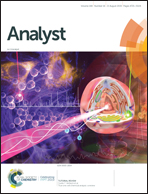Ultrasensitive fluorometric determination of iron(iii) and inositol hexaphosphate in cancerous and bacterial cells by using carbon dots with bright yellow fluorescence†
Abstract
An ON–OFF–ON dual-function fluorescent nanoprobe is described for the trace detection of ferric ions and inositol hexaphosphate (IP6) in living cells. It is based on the use of yellow-fluorescent nitrogen-doped carbon dots (YN-CDs). Highly fluorescent YN-CDs were synthesized by a hydrothermal process. They have an absolute quantum yield of 2.15% and excitation/emission peaks at 420/575 nm. Fluorescence is quenched by Fe3+via photo-induced electron transfer. The quenchometric assay has a 34 nM detection limit for Fe(III). On addition of IP6 which has a high affinity for Fe3+ due to the formation of Fe–O–P bonds, fluorescence becomes gradually restored. The resulting ON–OFF–ON assays for Fe(III) and IP6 are reliable and sensitive. IP6 can be detected at concentrations as low as 2 nM. The nanoprobe was then applied to the determination of Fe3+ and IP6 in living cells in a food matrix. Furthermore, YN-CDs exhibited excellent biocompatibility. Hence, the probe can be applied as a fluorescent ink for bioimaging, both in vitro (cancer cells and bacteria) and in vivo (nematodes and mice).



 Please wait while we load your content...
Please wait while we load your content...